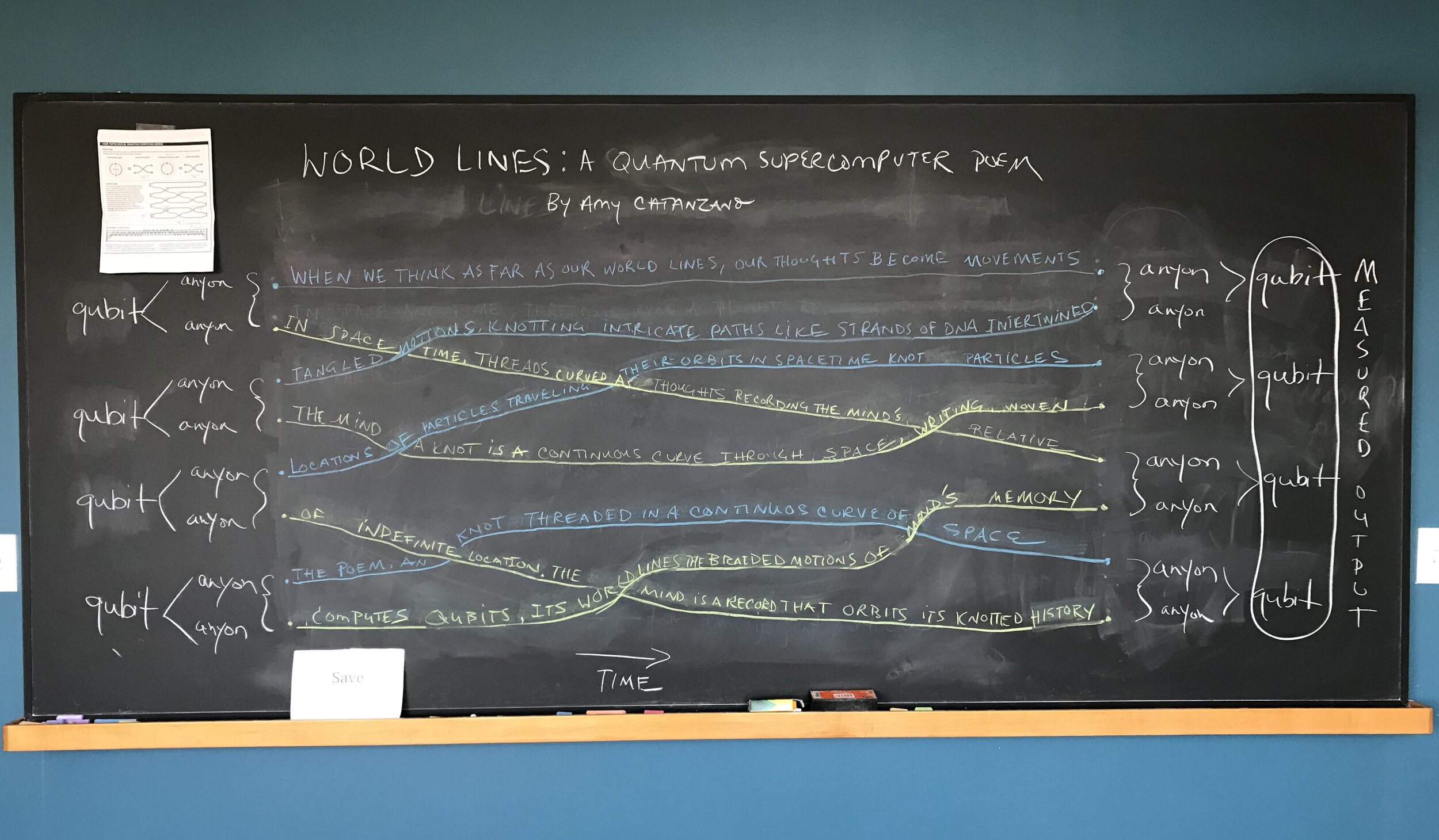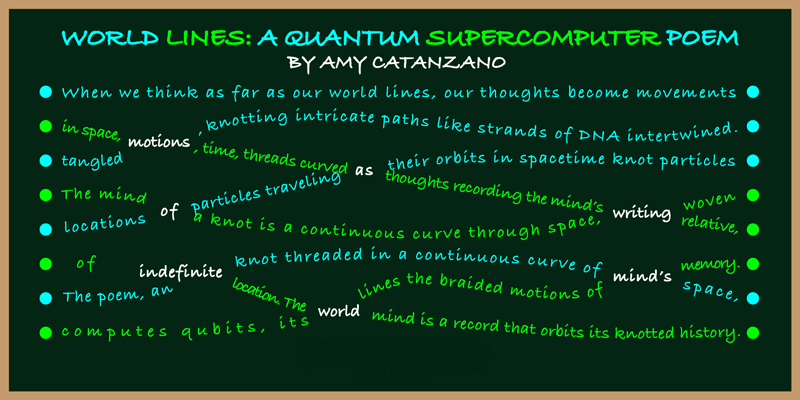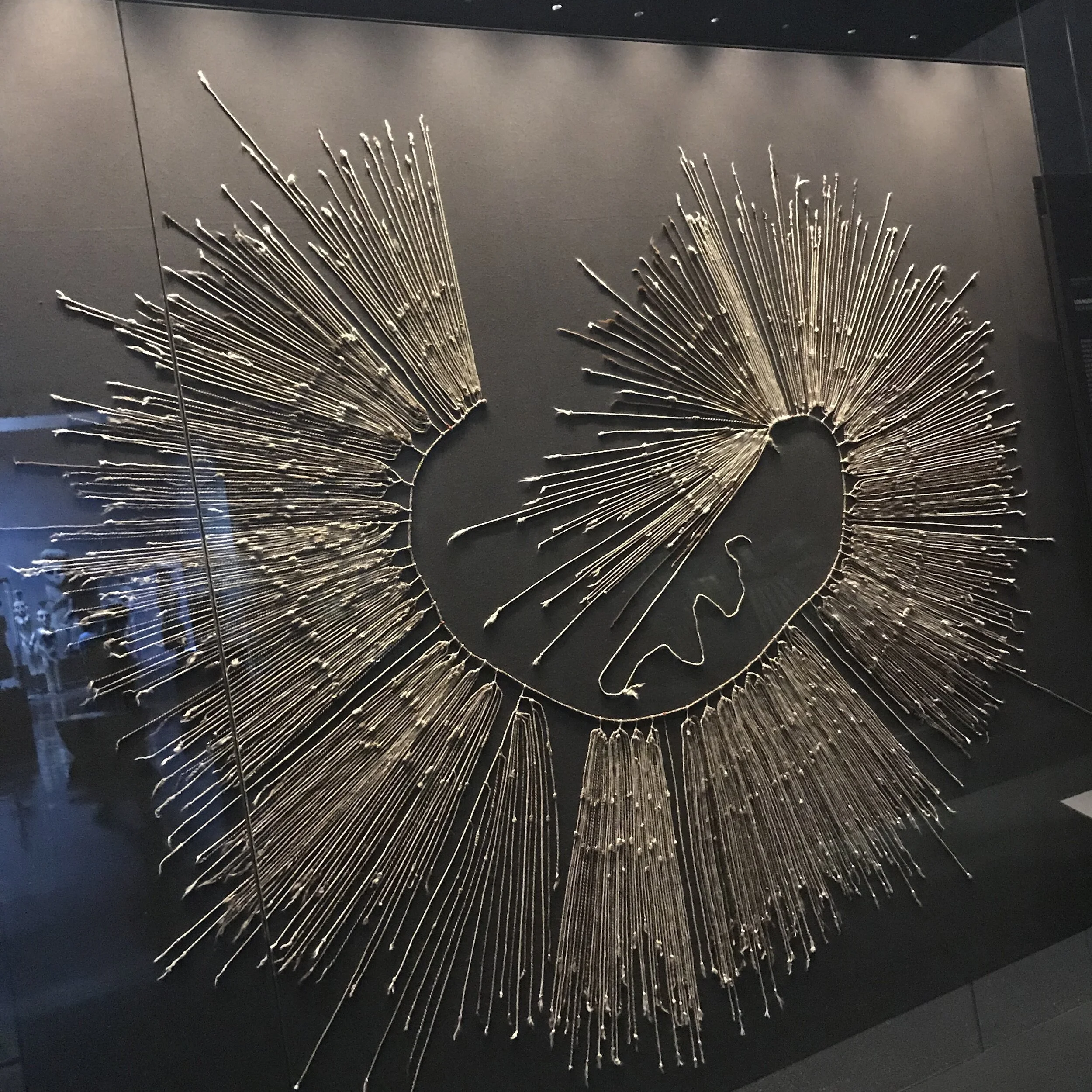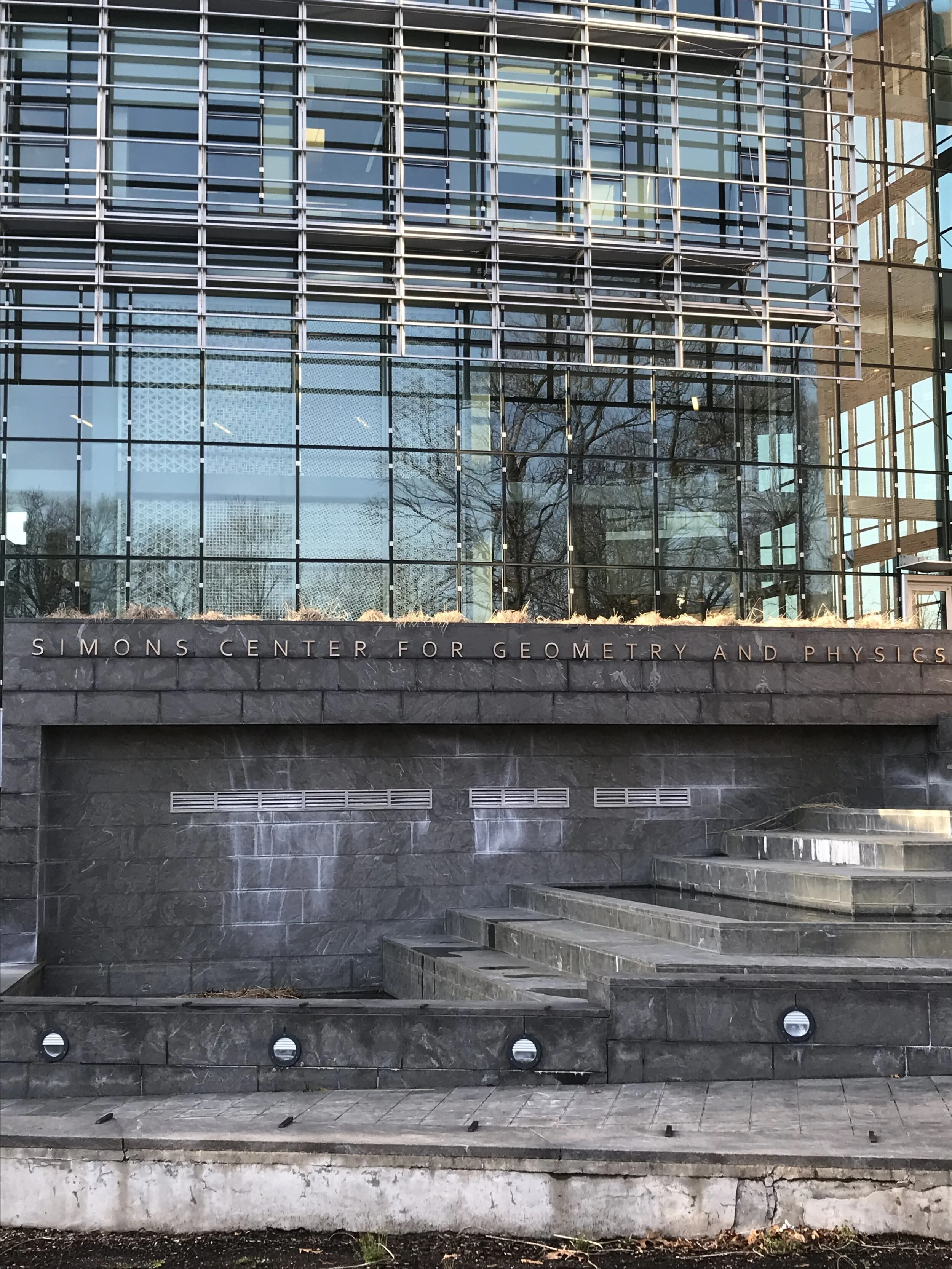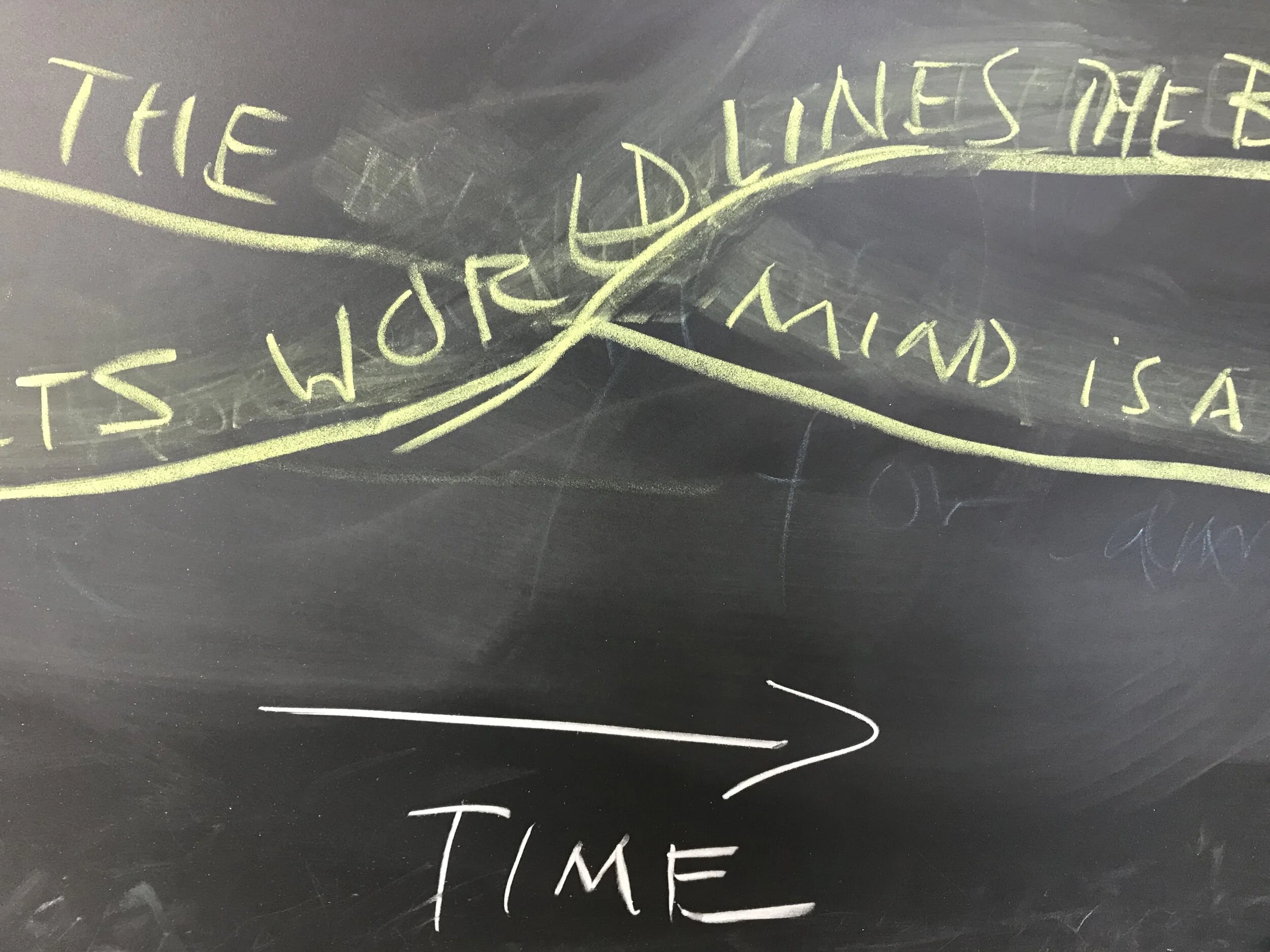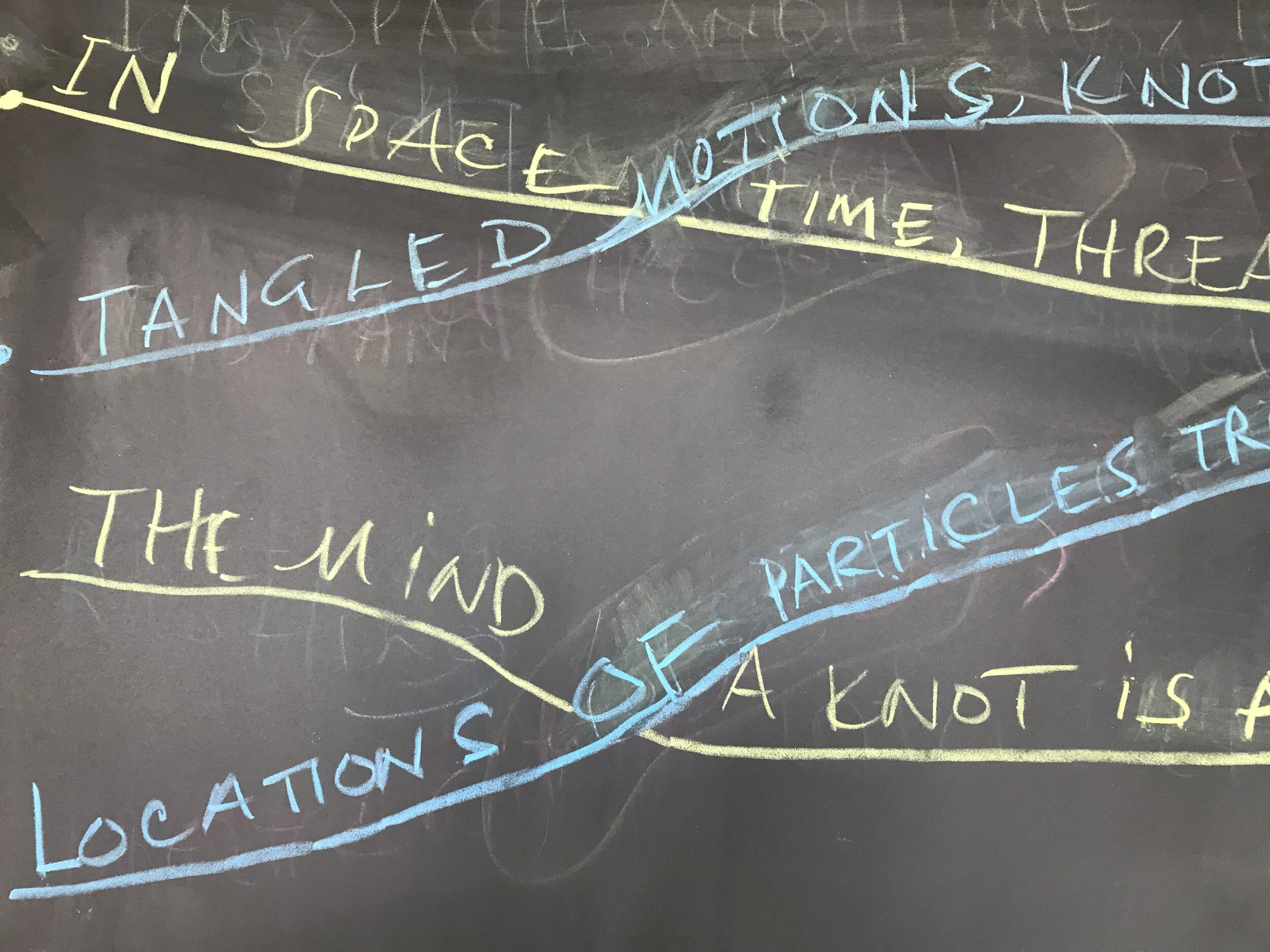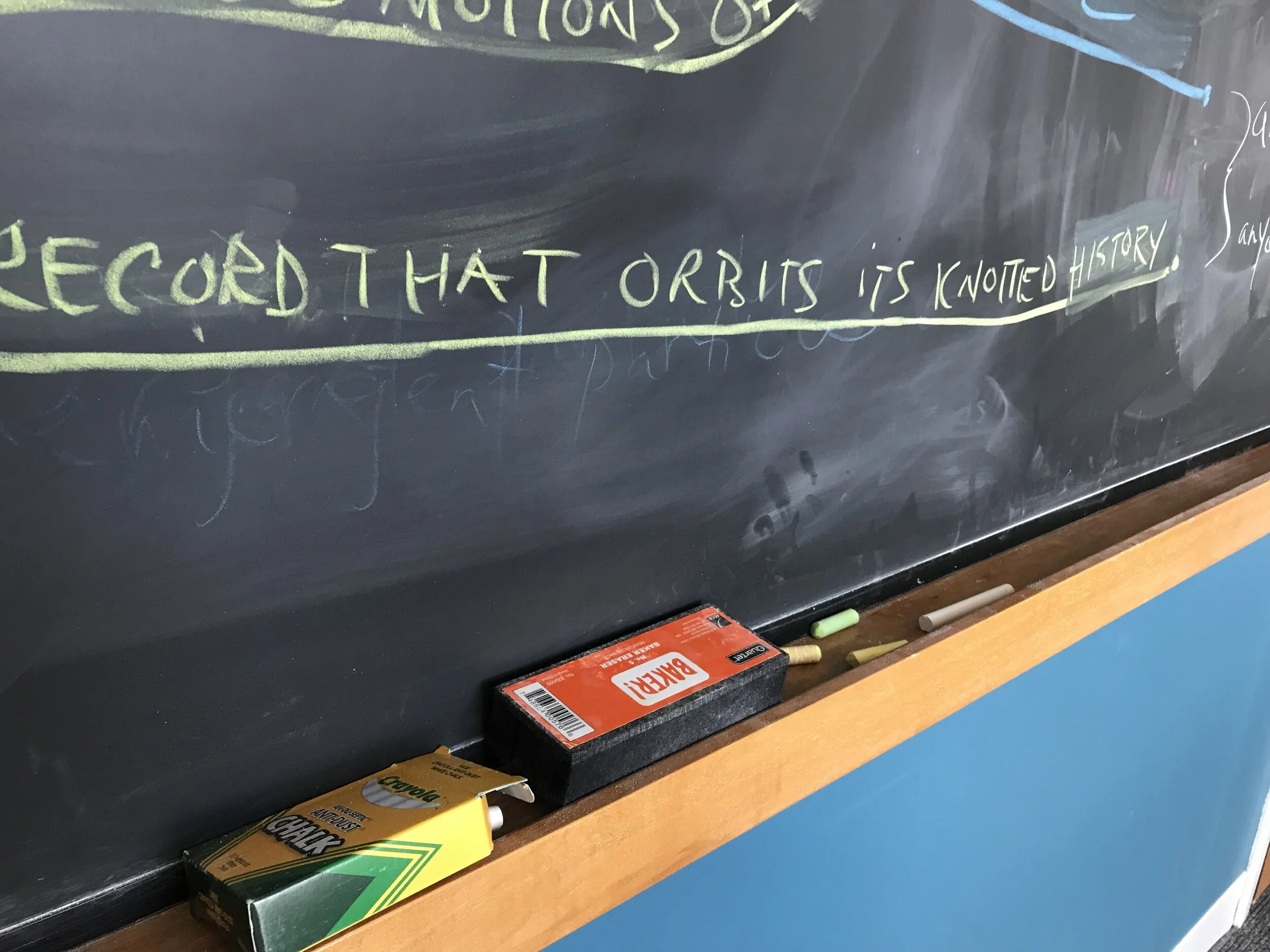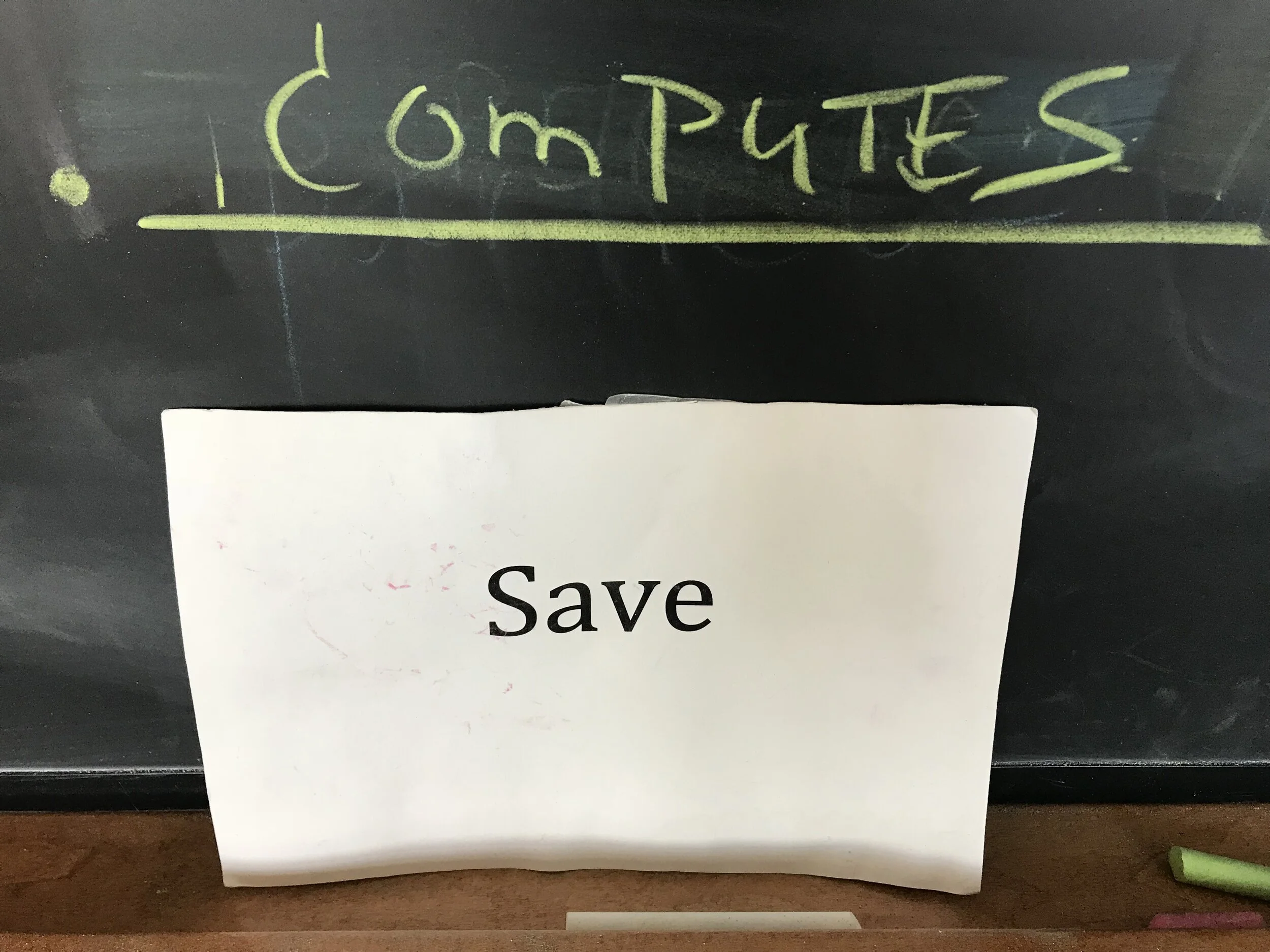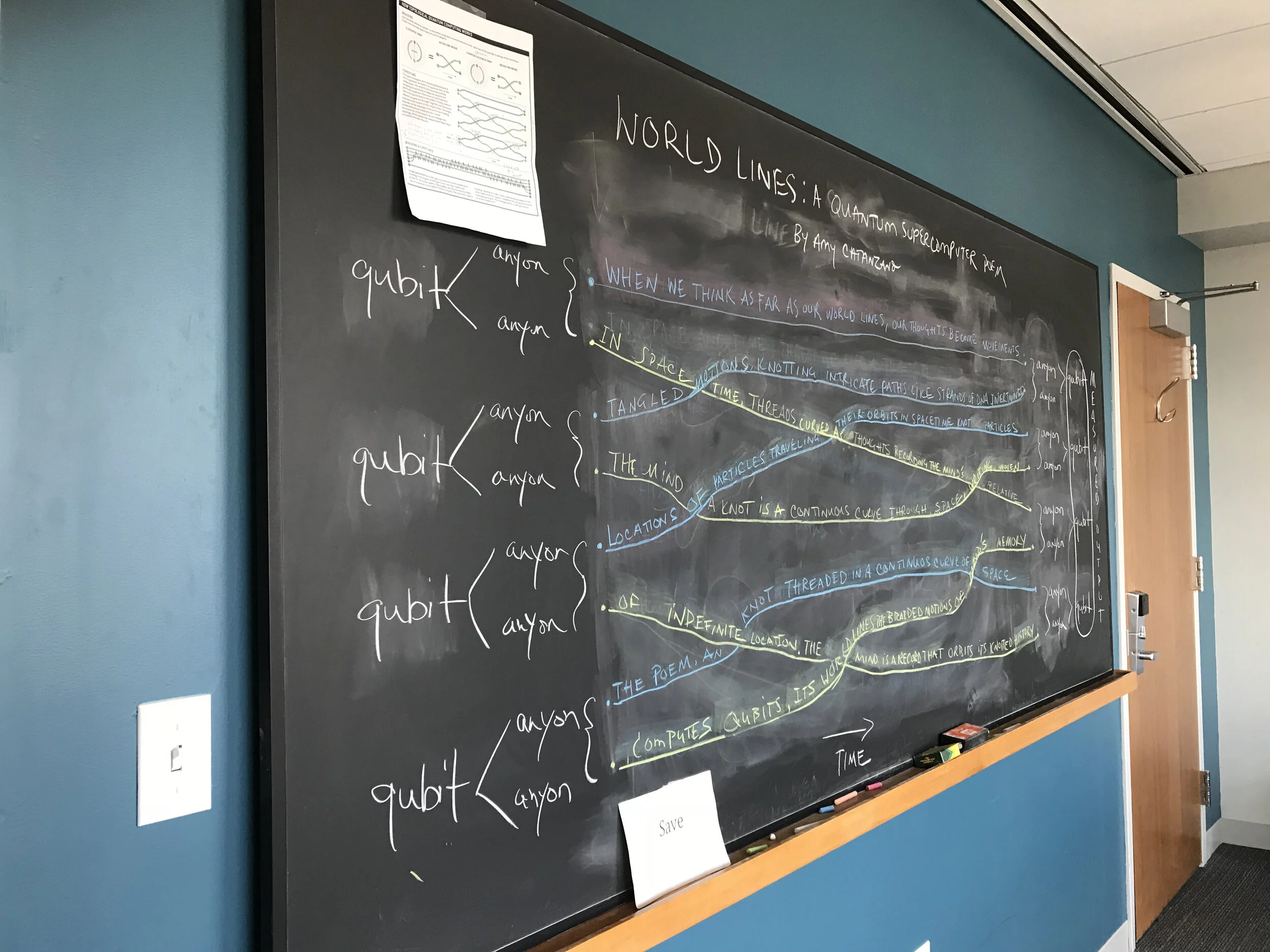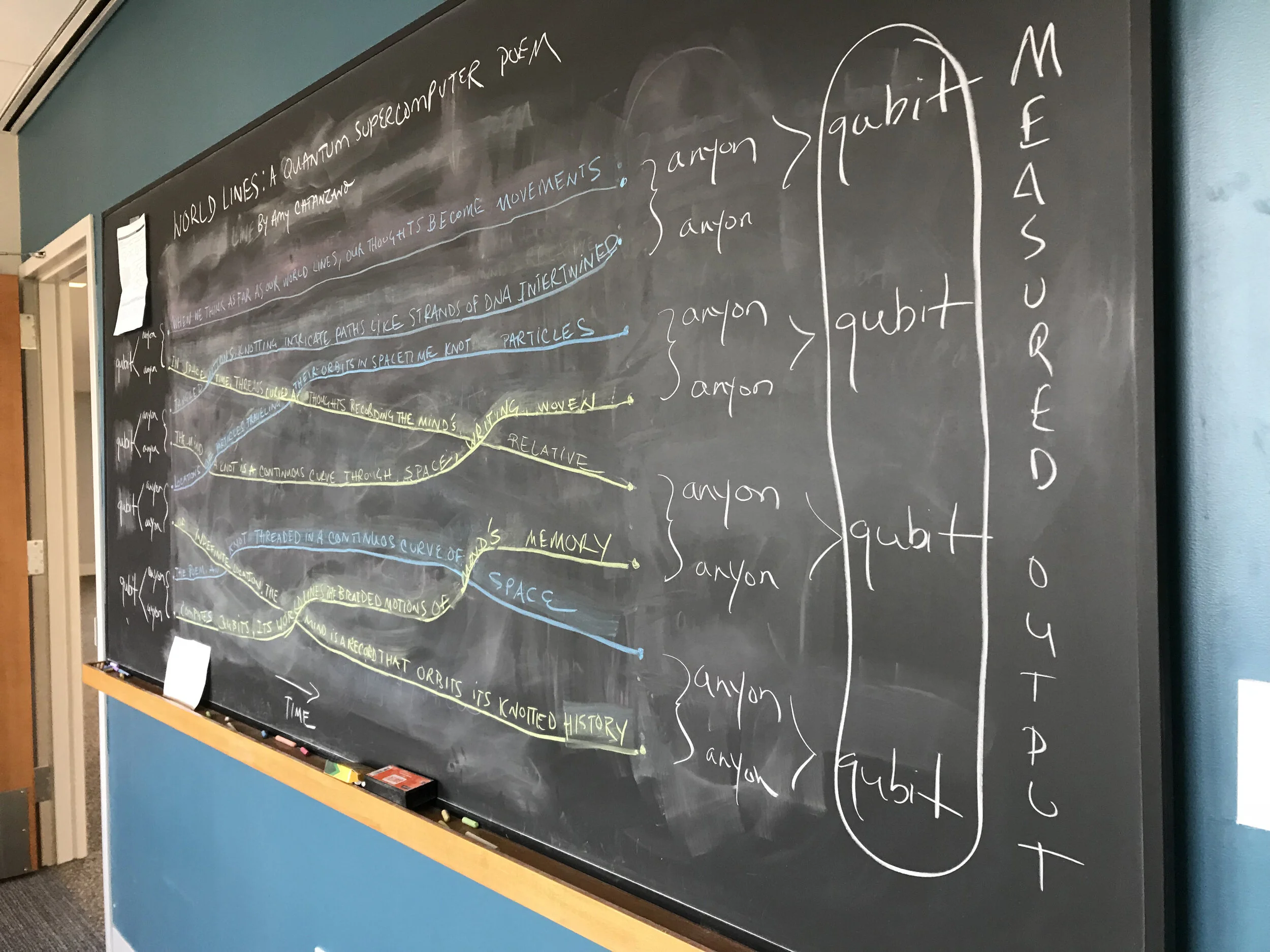World Lines
A Quantum Supercomputer Poem (2018-present)
Creation (Phase 1 complete)
Computational Poetry/Web Portal (Phase 2 underway)
Arts Installation (anticipated)
Some of this material first appeared in the chapbook, World Lines: A Quantum Supercomputer Poem, published as Phase 1 of the project by the Simons Center for Geometry and Physics at Stony Brook University (2018), and has since been expanded.
Statement of PoeticS
Introduction
During a site visit to the Simons Center for Geometry and Physics at Stony Brook University in October 2017, I spoke with theoretical physicist Giuseppe Mussardo about topological quantum computing, which led, six months later, to my development of Phase 1 of World Lines: A Quantum Supercomputer Poem. The poem uses a theoretical model of a topological quantum computer as its poetic form. While unique in adapting a highly experimental, cutting-edge, and promising approach to quantum computing as a poetic form, which makes the poem behave like a quantum system, the poem is not unlike formalist poems such as sonnets and sestinas, the constrained writing techniques of the Oulipo writers, or scientific experiments that follow predetermined rules to produce intended (or unintended) results.
I was invited to the Simons Center by its director, theoretical physicist Luis Álvarez-Gaumé, during a visit to CERN the year before, and was hosted by him and artist Lorraine Walsh, visiting associate professor of art at Stony Brook and art director and curator for the Simons Center. When I returned to the Simons Center in April 2018 as its inaugural poet-in-residence, and after conducting independent research on quantum computing with resources provided by Mussardo, I wrote my first draft of World Lines (below) on the chalkboard in my temporary office at the Simons Center. I presented it the next day in a poetry reading and talk.
First draft of Amy Catanzano’s World Lines, Simons Center for Geometry and Physics, 2018, photo by the author
In the audience for a portion of my presentation was Katherine Wright, senior editor of Physics, the online magazine of the American Physical Society. Wright later and wrote an article, “Poetry takes on quantum physics,” for Physics. The article was shared widely on social media and selected by the magazine’s editors as one of their 2018 Highlights of the Year. Working from my first draft of the poem, and with a revision I provided, Physics created an image (below) to present the poem to readers. But in order to “read” the poem, one has to be familiar with topological quantum computing, the scientific form in which World Lines is written.
Amy Catanzano; APS/Alan Stonebraker
How topological quantum computing works
The theoretical model of the topological quantum computer that I used for World Lines is represented in a diagram, “How Topological Quantum Computing Works,” appearing in a Scientific American article (below) given to me by Mussardo. In the model, pairs of quasiparticles known as anyons, which exist in two-dimensional electronic fluids, are created and lined up in rows to represent qubits, the quantum bits in a quantum computer. Qubits can exist as one, as zero, or as any quantum superposition of one and zero, where one and zero exist in any and all possible points in space and in any and all possible times.
Each qubit in the model of the topological quantum computer that I used has two anyons that are swapped clockwise and counterclockwise in a predetermined order with adjacent anyons, creating a braid. The pairs of the adjacent anyons are measured to produce the output of the computation (Collins, 57-53).
Nature.com, “Computing with Quantum Knots,” Graham P. Collins, Scientific American 294, 56-63 (2006). doi:10.1038/scientificamerican0406-56. Credit: George Retseck.
The trajectories in time that the anyons make as they are braided are known as “world lines,” the historical paths that an object traces (Collins 58) in spacetime. Theoretical physicist and Nobel laureate Frank Wilczek, who coined the term “anyon,” says that world lines are records of relative motion, a memory of an object moving (Wilczek 10). I learned from Mussardo that at each intersection of world lines resulting from the movement of the anyons, a knot can be made, both from the braiding itself and by identifying the ends of the world lines. As part of his work as a theoretical physicist, Mussardo creates theoretical models of these quantum knots, and he sent me an image of one that he developed (below) for my studies.
Quantum knot combining Borromean rings and orbitals of the Quantum Hall effect, courtesy of Giuseppe Mussardo
Quantum knots and quipu knots
To my great interest, Mussardo mentioned that the quantum knots in topological quantum computing are thought to be related to the Incan textile known as quipu, connected cords and ropes with knots woven into them. I was aware that the Inca, who did not have a traditional written language, used quipus as a sophisticated system for computation and encryption. I first became familiar with quipus through the New York-based Chilean poet and artist Cecilia Vicuña, who evokes quipus in her performances, art installations, and “quipoems.” Over the years, I had attended performances by her at Naropa University and elsewhere, where she loosely threads yarns around the audience, figuratively weaving the audience into quipu knots.
Vicuña’s artistic work with quipus has not only aesthetic but political dimensions. In statements on this work, she suggests that quipus were used both for computation and as an under-recognized language for making meaning. In addressing their destruction and banishment in South America during and after the Spanish Conquest, she situates her work with quipus as an act of rebellion against colonialism “to begin again the process of speaking through the threads” (Vicuña, Quipu Astral). In her poem, “Word & Thread,” Vicuña says that a quipu “is a poem in space, a way to remember” (Ubuweb), which, in addition to its political challenge to European colonialism, evokes Wilczek’s definition of a world line as a memory of an object moving.
As I began studying topological quantum computing, Mussardo sent me an article from Quanta Magazine by Frank Wilczek, who discusses the relationship between quantum computing and quipu knots:
Computing with anyons exploits their ability to map their knotted histories into (observable) quantum-mechanical amplitudes. We move anyons around in clever ways and then access the tangled history of their motion. Topological quantum computing is, therefore, a form of computing with knots. As such, it is a modernization of quipu, the Incan technology for computation and encryption. (Wilczek 15)
It was this connection that Wilczek made between quipu and topological quantum computing that initially motivated me to study both structures in direct relation to poetic principles and creative praxis.
Eight months after I developed Phase 1 of World Lines at the Simons Center with the originary poem, I was in north-central Chile, high up in the Andes mountains, on a site visit to the Cerro Tololo Inter-American Observatory to conduct research on the Dark Energy Survey for a different project, This World: A Poem for the Dark Energy Survey. After I left Cerro Tololo, I flew to Santiago and saw, for the first time in person, quipus at the Museo Chileano De Arte Precolombino. Soon I met up with Cecilia Vicuña in Santiago. She told me that she thought that the large, connected quipu (below) that I had just seen at the museum is the most striking quipu left in the world. I shared with her that its arrangement at the museum reminded me of the wondrous galaxies I had just seen at Cerro Tololo in the control room of the Victor M. Blanco telescope. It made me imagine galaxies as quipu and topological quantum computers, computing by sun, moon, and planet-knots.
A thought experiment in quantum poetics
If a quipu is a poem in space, a substitution for ordinary language that offers alternative ways to remember as Vicuña has suggested, it functions like a world line, the historical path—which is also a record of the path—of an object as it moves through space in time. Lines of poetry written on two-dimensional surfaces like paper can be viewed as world lines that trace the history of letters moving across the page in time. This performs a literary act by providing meaning and interpretation, which is a type of computation.
Minutes before I created World Lines in my office at the Simons Center, I was wondering: What parts of a poem could represent the complex knots in both quipus and topological quantum computers?
Like the woven knots in quipus and the quantum knots in topological quantum computing, poetry is a combined spatial site and temporal moment of complexity. In a poem, complexity is situated in language that both compresses and lengthens the record of the traveling path of its poetic (world) lines. World lines are subject to the principle of indeterminacy (known as the uncertainty principle) in quantum theory, where, due to the non-commutative properties of position and momentum, measuring the position of a subatomic particle changes its momentum and vice versa. Further, both the position and momentum of a subatomic particle can only be measured as probabilities, not certainties or deterministic outcomes.
Having this prior knowledge of quantum physics led me to consider if quantum knots and quipu knots are unacknowledged poetic devices, where the length and breadth of their constituent parts gathers in a compressed location and moment. In this thought experiment in what I call “quantum poetics,” where I explore poetry in relation to physics, it’s possible to grasp that poetry, like other intellectual and creative endeavors, can braid thoughts in the mind to create a shorthand where meaning is arrived at in a condensed form.
Just before I created World Lines, I also reminded myself that I was working at two quantum scales at once: poetics and quantum computing. Rather than treating each scale separately, I knew that I had to try and perceive them simultaneously in a superpositional quantum state, which Niels Bohr called “complementarity,” where a photon or quanta of light is both a wave and a particle at the same time until measured or observed. The key, therefore, to my creative praxis was resisting classical approaches to my experiment by letting my mind inhabit quantum superposition as I explored poetry and quantum computing in union.
I also was directly motivated by knowing that scientists had suggested that language is inadequate in describing quantum systems. In his book, Physics and Philosophy (1958), Werner Heisenberg, co-founder of quantum theory, references Johann Wolfgang Von Goethe’s verse play, Faust, after articulating the problem that quantum theory does not have a language beyond mathematics to describe it. Heisenberg quotes Mephistopheles, who says that while formal education instructs that logic braces the mind “in Spanish boots so tightly laced” (or “braided”), and that even spontaneous acts require a sequential process,
In truth the subtle web of thought
Is like the weaver’s fabric wrought:
One treadle moves a thousand lines,
Swift dart the shuttles to and fro,
Unseen the threads together flow,
A thousand knots one stroke combines. (171)
Mephistopheles is arguing that creative thinking, unlike the rationality of formal education, goes beyond logic and sequential processes. The “subtle web of thought”—for example, the complexities in quantum knots, quipu knots, and poetry—happens when one gesture quickly leads to others, flowing together in unseen ways or ways that cannot be discerned by ordinary analysis. While on the surface representing a malignant, supernatural figure to whom Faust must sell his soul in order to gain what he desires, Mephistopheles also symbolizes logic, knowledge, and authority and, as a result, acts as a sophisticated advocate of materialism and skepticism in the Faust legend, concepts that are deeply embedded within the Western scientific worldview.
When Heisenberg, influenced by Max Born’s symbolic multiplication and the relationship that Max Planck established between mass and frequency, had the insight to develop a novel matrix mechanics for quantum theory, which led to the uncertainty principle using visual grids or matrices, his mind was behaving creatively like a poem, a fabric constructed by a thousand knots combined in one stroke.
Heisenberg says that the passage from which the quote by Mephistopheles appears “contains an admirable description of the structure of language and of the narrowness of the simple logical patterns” (171). His comments speak to his interest in broadening what constitutes logic in quantum theory and the inability of ordinary language to describe what happens inside the atom. My own work in quantum poetics examines this issue by investigating if poetic language is more capable than ordinary language of describing subatomic and cosmological scales of matter. World Lines is one experiment testing this principle in quantum poetics.
The passage by Mephistopheles that Heisenberg quotes can be used to describe not only rational and creative thinking but poetry itself. Poetry, as a complex form of creativity, can function as a literary shorthand like “one treadle” moving “a thousand lines,” where a “thousand knots one stroke combines.” One “stroke” of the “treadle,” the loom that weaves the complex thoughts referenced in Faust, can move “thousands of lines” or units of language in a poem where thousands of more “knots” or sites of complexity combine. This ability of poetry to condense language into sites of complexity through literary devices makes poetry a shorthand (Eckhoff 81), where points of complexity converge through the action of the poem.
Shorthand, which lessens the amount of space and time it takes for information to travel, evokes the concept of an Einstein-Rosen Bridge, a spatio-temporal wormhole, which connect sites in different spacetimes, creating passage. In previous essays of mine in quantum poetics, I have speculated that a poem is a kind of quantum computer or wormhole made of language that functions as an emergent site of complexity through the computation of writing, reading, or speaking. A reader, in this expanded definition of poetry, can be thought of as traveling a poem, rather than reading it, by perceiving the simultaneity of its knotted world lines.
The breakthrough
In the model of the topological quantum computer that I used as a poetic form for World Lines, each qubit has two anyons and is represented by two world lines, a green world line and a blue world line. The chalkboard in my office at the Simons Center came with different colors of chalk, including blue chalk and green chalk. As part of my poetic process, I was alert to all input on my creative path, including that which may appear unrelated to my goals. Seeing the blue and green chalk at the base of the blackboard led me to think about how the world lines used in the diagram of the model were represented in blue and green ink, symbolic of the world, which is made of so much green and blue in our flora, skies, and seas.
Seeing the colors in the diagram of the quantum computer alongside the colors of the chalk, I realized that I could use the chalkboard as a circuit board to engineer a poem by translating the model of the computer to create four color-coded poetic stanzas. I proceeded to draw the model on the chalkboard and then wrote poetry over each line, which made each stanza a couplet of two qubits that correspond to the blue and green world lines in the model. I had created a new world, I mused, one drawn with poetic lines that were also world lines in a theoretical topological quantum computer.
What are the physics, and poetics, of this new world?
How World Lines works
My process created four pairs of poetic couplets with eight anyons total in my use of the four-qubit topological quantum computer. A blue extended line of poetry functions as one world line of the braid, and a green extended line of poetry functions as the other world line of the braid. At the point of intersection where the braiding or lacing occurs in the poem—and through the action of the quantum knots in the topological quantum computer that evoke quipus—I developed a shared word, shown in white on subsequent images of the poem, that each line of poetry needs in order to more or less syntactically make sense.
In the clockwise swapping of the world lines in my poem, the bottom anyon in the anyon pair is placed over the world line that is forged by the top anyon in the anyon pair. In the counterclockwise swapping of the world lines in the poem, the top anyon in the anyon pair is placed over the world line that is forged by the bottom anyon in the anyon pair. By connecting the world lines in the poem to perform its computation, the shared words highlight the way that a qubit can exist as a one, a zero, or any quantum superposition of one and zero, unlike a digital bit that can exist only as one or zero.
The shared word at each intersection also demonstrates how a poem might function as a qubit: each shared word can be a word for the green world line, a word for the blue world line, and a word for both world lines in a quantum superposition of the green world line and the blue world line, suggesting that the shared word is a site of complexity like the woven knots in quipus and quantum knots in topological quantum computers.
One exciting outcome of World Lines is that there are many possible poems inside the poem. Each version or variant of the poem can be viewed as existing in a quantum superposition, in all possible points in space and at the same time. Since the reader can decide which world line to follow, and thus which version of the poem to read, the act of reading the poem performs a quantum measurement and, in the Copenhagen interpretation of quantum theory, collapses the wave function of the lines being read as that version of the poem is defined or comes into existence. Like a quantum computer or quipu, it is through the poem’s knots, the shared words, that the poem’s meaning is interpreted or computed by a reader. Wright, in her article, explains further:
In her poem, Amy Catanzano replaces the weaving anyons with four poetic couplets, which crisscross over one another. Where two lines intersect, they share a word, a literary device…Catanzano used to evoke an anyon knot. These textual knots are like forks in the reader’s path. The text can be read linearly—following each line of text sequentially—or the reader can jump from one line to another when they encounter a textual knot. Different paths through the poem create unique word-braids and lead to different “calculations,” just as in a topological quantum computer. “World Lines: A Quantum Supercomputer Poem” translates the quantum theory behind a topological quantum computer in both its word choices and its visual structure….(Physics)
Tristan Greene, in his article, “Artist explains quantum theory through poetry,” discusses the different paths the reading can take in the poem:
The poem contains four poetic couplets that twist and intersect. Specific words lie at the center of more than one sentence, forcing the reader to choose which words to read next. Because of this, the poem can be read several different ways without losing its message. Think of it like Schr[ö]dinger’s poem: Until you read it, it’s several different poems at once….In quantum computing a qubit—like a computer bit, but quantum—can exist in more than one state at a time. It’s only when a qubit is observed that the universe reveals the mystery of its position (and even then, scientists disagree on whether such a measurement is a ground-truth or not). Amy Catanzano’s work invites the reader to make the ultimate decision. Is the word you’re reading part of one sentence, or another? Once you decide, as the universe does when a qubit is observed, the poem exists as you’ve chosen to read it. Perform another measurement, meaning read it again, and you have the opportunity to change the nature of the poem. (The Next Web)
Rather than attempting to describe how quantum physics works by using ordinary language in expository prose, which is how science is most often communicated to broad audiences, or by talking about quantum physics in narrative poetry, which is how science is most often explored in literary art, World Lines can be interpreted as a quantum system by enacting principles in quantum theory. Further, the poem does not only perform principles in subatomic physics; it also performs principles in poetics. In one of many possible versions of the poem that appears below, World Lines explores how a poem like itself can be woven by the mind into an indefinite quantum-quipu knot that computes information, which turns the mind contending with such a poem into both a poem and quantum computer, or what I call a “quantum supercomputer poem.”
Amy Catanzano, World Lines: A Quantum Supercomputer Poem, 2019, one of many possible versions
Conclusion and next steps
Creating World Lines allowed me to develop a unique site of interaction between poetry and quantum computing through poetic methodology and scholarly study. While it took me just an afternoon to draw the theoretical model of the topological quantum computer and write lines of poetry over it on the chalkboard when I had the idea to do so, it was an extended investigatory process to get there, one that began with my first site visit to the Simons Center, where I talked with Mussardo. The poem also has roots in my preceding site visit to CERN, where I first talked with Álvarez-Gaumé and was invited to the Simons Center.
Such site visits to scientific research centers not only give me opportunities to talk with scientists, they provide me an enriched setting in which to create. My activities during my first visit to the Simons Center, for example, included attending presentations by Mussardo, who gave a lecture on a special kind of zero, and artist Lisa Park, who discussed her installation art involving the human heartbeat. During my second visit, I attended presentations by philosopher Robert Crease, who discussed the role of beauty in scientific experiments, and theoretical physicist and Nobel laureate Kip Thorne, who discussed the discovery of gravitational waves.
While phase 1 of the originary poem in World Lines described above is complete with the publication of the chapbook, in Phase 2 I am working with computer and climate scientist Michael Taylor on a multimodal, computational version of the poem that will result in a book collection and interactive web interface. Taylor has used the Python computer programming language, machine learning, and artificial intelligence technology to develop an algorithm and quantum script that computationally expresses all possible versions of World Lines. After parsing each sentence in the poem and identifying branch points—words in common—Taylor trained a linguistic processor to choose world lines that are semantically logical to track how different topological paths move through a text map into different versions of the poem. I am using these variants as well as data from Taylor’s computational process that created the variants for a book collection of computational poetry. The book may explore theoretical investigations of quantum linguistics and information theory in relation to principles in poetics. Visual artwork and translations of the variants also are being developed.
Taylor and I also are developing a web interface, where, after a text is loaded, a World Lines algorithm can find the branch points and do one of two things: 1) allow the reader to manually navigate along a world line, creating a new poem as a re-structured sample of the text that could be stored and studied, and 2) run a simulation and generate world lines that the reader can choose between in order to render new poems.
While Phase 2 merges quantum mechanics with electronic literature, Phase 1 of World Lines can be viewed as a post-digital poem in that it uses quantum computing, rather than digital computing, as its primary form.
For phase 3, I am taking steps to translate World Lines into an interactive art installation. In August 2019, during my second site visit to CERN, I spoke with physicist and multimedia storyteller Joao Pequenão, head of the CERN MediaLab, about my goal. He suggested a number of exciting possibilities to bring the poem into a 3D environment, among them gaming technology, machine learning, and virtual reality. I imagine an interactive environment through which the reader writes the version of the poem that they choose to walk.
Updated March 26, 2023
Works Cited
Collins, Graham P. “Computing with Quantum Knots.” Scientific American, April 2006, pp. 57-63.
Eckhoff, Kevin Mcpherson. Rhapsodomancy. Toronto: Coach House Books, 2010.
Greene, Tristan. “Artist explains quantum theory through poetry.” The Next Web, 12 October 2018, https://thenextweb.com/distract/2018/10/12/artist-explains-quantum-physics-through-poetry/.
Heisenberg, Werner. Physics and Philosophy: The Revolution in Modern Science. New York: Harper and Row, 1958.
Mussardo, Giuseppe. “Re: A few questions about quantum topological computation.” Received Amy Catanzano, 2, April 2018.
Ubuweb, Ethnopoetics: Poems, ubu.com/ethno/poems/vicuna_word.html.
Vicuña, Cecilia. Artist’s website, www.ceciliavicuna.com/quipus.
Wilczek, Frank. “How Anyon Particles Emerge from Quantum Knots.” Quanta Magazine, February 2017, pp. 10-15.
Wright, Katherine. “Poetry takes on quantum physics.” Physics, 11 October 2018, https://physics.aps.org/articles/v11/103.
